disease
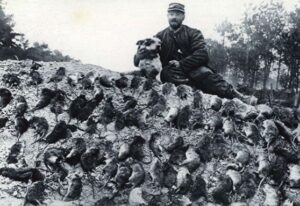
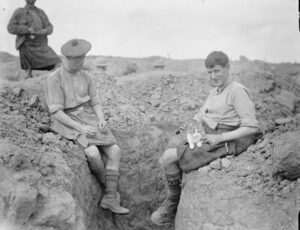 Trench warfare is a type of land warfare using occupied lines largely comprising military trenches, in which troops are well-protected from the enemy’s small arms fire and are substantially sheltered from artillery. That doesn’t protect them from many other weapons, like tanks, bomber planes, and some things that seem far more benign…rats and disease, not that these things aren’t dangerous. In fact, during World War I, these seemingly benign pests were becoming a deadly problem. Trench foot was one of the biggest disease problems, due to the wet and dirty conditions the men basically lived in.
Trench warfare is a type of land warfare using occupied lines largely comprising military trenches, in which troops are well-protected from the enemy’s small arms fire and are substantially sheltered from artillery. That doesn’t protect them from many other weapons, like tanks, bomber planes, and some things that seem far more benign…rats and disease, not that these things aren’t dangerous. In fact, during World War I, these seemingly benign pests were becoming a deadly problem. Trench foot was one of the biggest disease problems, due to the wet and dirty conditions the men basically lived in.
The rats…well, they were a bigger problem. The fact that the men “lived” in the trenches meant things like human waste, food scraps, and dead bodies drew the rats, and rats spread disease like typhus and the plague,  which made the problem of disease more deadly. Since trash disposal wasn’t easy in the trenches, the men often threw empty food tins out of the trenches at night. Then, the rats could be heard turning the tins over and licking the last tidbits out of them. For me the whole scene would be enough to make me want to run screaming from the scene, but that could get a soldier killed. Something had to be done…and done quickly. Due to the plentiful amount of food, some of these rats grew quite large in size. One story tells of a soldier who spotted one the size of a cat.
which made the problem of disease more deadly. Since trash disposal wasn’t easy in the trenches, the men often threw empty food tins out of the trenches at night. Then, the rats could be heard turning the tins over and licking the last tidbits out of them. For me the whole scene would be enough to make me want to run screaming from the scene, but that could get a soldier killed. Something had to be done…and done quickly. Due to the plentiful amount of food, some of these rats grew quite large in size. One story tells of a soldier who spotted one the size of a cat.
Something had to be done, so French troops tried to control the rat problem by bringing terrier dogs into the trenches with them. The plan was to let the dogs catch and kill rats, and it quickly became an interesting way to pass the time during daylight hours. Because of the dangers presented by the rats, the military actually offered soldiers a reward for killing the rats as incentive to decrease their numbers. It was a great idea, but not really practical, because rats are notoriously great escape artists…at least from humans. Nevertheless, apparently the troops got so into the 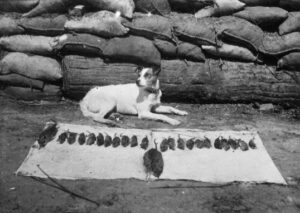
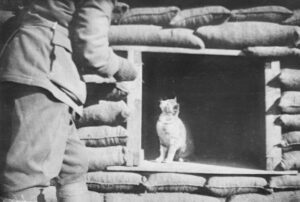 game, with one army corps managed to catch 8,000 in a single night. Other soldiers adopted cats instead of dogs, and it’s believed around 500,000 cats helped out in the trenches over the course of World War I. Many of the cats, and some of the dogs, ended up serving as mascots for troops on the front lines as well as hunters. I guess the plan worked, but maybe the animals should have been given a medal too.
game, with one army corps managed to catch 8,000 in a single night. Other soldiers adopted cats instead of dogs, and it’s believed around 500,000 cats helped out in the trenches over the course of World War I. Many of the cats, and some of the dogs, ended up serving as mascots for troops on the front lines as well as hunters. I guess the plan worked, but maybe the animals should have been given a medal too.
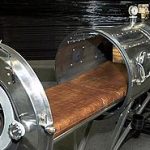 Called an Iron Lung, the negative pressure ventilator was a common tool used to treat polio when that disease was deadly and much feared. Poliomyelitis, which is often called polio or infantile paralysis, is an infectious disease caused by the poliovirus. In about 0.5 percent of cases there is muscle weakness resulting in an inability to move. This can occur over a few hours to a few days. The weakness most often involves the legs but may less commonly involve the muscles of the head, neck and diaphragm. Many people fully recover. In those with muscle weakness about 2 to 5 percent of children and 15 to 30 percent of adults die. Another 25 percent of people have minor symptoms such as fever and a sore throat and up to 5 percent have headache, neck stiffness and pains in the arms and legs. These people are usually back to normal within one or two weeks. In up to 70 percent of infections there are no symptoms. Years after recovery post-
Called an Iron Lung, the negative pressure ventilator was a common tool used to treat polio when that disease was deadly and much feared. Poliomyelitis, which is often called polio or infantile paralysis, is an infectious disease caused by the poliovirus. In about 0.5 percent of cases there is muscle weakness resulting in an inability to move. This can occur over a few hours to a few days. The weakness most often involves the legs but may less commonly involve the muscles of the head, neck and diaphragm. Many people fully recover. In those with muscle weakness about 2 to 5 percent of children and 15 to 30 percent of adults die. Another 25 percent of people have minor symptoms such as fever and a sore throat and up to 5 percent have headache, neck stiffness and pains in the arms and legs. These people are usually back to normal within one or two weeks. In up to 70 percent of infections there are no symptoms. Years after recovery post- polio syndrome may occur, with a slow development of muscle weakness similar to that experienced during the initial infection. Polio is more common in infants and young children, occurring under conditions of poor hygiene.
polio syndrome may occur, with a slow development of muscle weakness similar to that experienced during the initial infection. Polio is more common in infants and young children, occurring under conditions of poor hygiene.
Because of complete or partial loss of muscle usage, people with polio had a difficult time breathing, which can cause a myriad of problems, including pneumonia. Enter the Emerson iron lung. The affected patient lies within the chamber, which when sealed provides an effectively oscillating atmospheric pressure. A negative pressure ventilator, or iron lung, is a nearly-obsolete mechanical respirator which enables a person to breathe on their own in a normal manner, when muscle control is lost, or the work of breathing exceeds the person’s ability, as may result from certain diseases. Polio was not the only disease that called for the iron lung. In addition to  Polio, botulism and certain poisons, such as barbiturates, tubocurarine, also benefited from its use.
Polio, botulism and certain poisons, such as barbiturates, tubocurarine, also benefited from its use.
Versions of the Iron Lung include both the Drinker respirator, the Emerson respirator, and the Both (Emerson-Drinker) respirator. The negative form of pressure ventilation…decreasing surrounding pressure to induce inhalation then re-pressurizing to 1 bar (15 psi; 750 mmHg)…has been almost entirely superseded by positive pressure ventilation (forcing air into the lungs with a pressure greater than 1 bar then allowing the body to naturally exhale before repeating) or negative pressure cuirass ventilation. While the iron lung is not used anymore, it served a useful purpose in its day.
 Heroes come in many forms, but few could be said to have been as sneaky as Eugene Lazowski, who was born Eugeniusz Slawomir Lazowski, in 1913 in Poland. His bravery was combined with genius, and in the end, he saved 8,000 Polish Jews at the height of the Holocaust. Lazowski saw the horrible way the Jews were treated, and he saw a way to help. Eugene Lazowski had just finished medical school when the Nazis invaded Poland in 1939. Typhus was spreading across the country. The disease was killing an average of 750 people a day. In an attempt to contain the disease, the Nazis increased their isolation and execution of Jews. Eugene joined the Polish Red Cross, but he was forbidden by the Nazis from treating Jewish patients. Nevertheless, under the cover of darkness, he sneaked into the Jewish ghetto and took care of the people there. Lazowski’s plan took an incredible amount of intellect, not to mention bravery. His life was on the line too. Lazowski created the illusion of an epidemic of a deadly disease, playing on the deep fears of the Nazis.
Heroes come in many forms, but few could be said to have been as sneaky as Eugene Lazowski, who was born Eugeniusz Slawomir Lazowski, in 1913 in Poland. His bravery was combined with genius, and in the end, he saved 8,000 Polish Jews at the height of the Holocaust. Lazowski saw the horrible way the Jews were treated, and he saw a way to help. Eugene Lazowski had just finished medical school when the Nazis invaded Poland in 1939. Typhus was spreading across the country. The disease was killing an average of 750 people a day. In an attempt to contain the disease, the Nazis increased their isolation and execution of Jews. Eugene joined the Polish Red Cross, but he was forbidden by the Nazis from treating Jewish patients. Nevertheless, under the cover of darkness, he sneaked into the Jewish ghetto and took care of the people there. Lazowski’s plan took an incredible amount of intellect, not to mention bravery. His life was on the line too. Lazowski created the illusion of an epidemic of a deadly disease, playing on the deep fears of the Nazis.
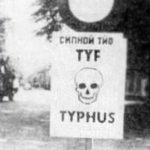 The plan came about in an unusual way. One day, a Polish soldier on leave begged Eugene and his colleague, Dr Stanislaw Matulewicz, to help him avoid returning to the warfront. I think there were many people who fought on the Nazi side of that era, who would give anything not to take part in what the Nazis were all about. Matulewicz had discovered that by injecting a healthy person with a vaccine of dead bacteria, that person would test positive for epidemic typhus without experiencing the symptoms. In an attempt to help the young solider fake a life-threatening illness, the doctors who had discovered that a dead strain of the Proteus OX19 bacteria in typhus would still lead to a positive test for the disease. Eugene realized that this could be used as a defense against the Nazis.
The plan came about in an unusual way. One day, a Polish soldier on leave begged Eugene and his colleague, Dr Stanislaw Matulewicz, to help him avoid returning to the warfront. I think there were many people who fought on the Nazi side of that era, who would give anything not to take part in what the Nazis were all about. Matulewicz had discovered that by injecting a healthy person with a vaccine of dead bacteria, that person would test positive for epidemic typhus without experiencing the symptoms. In an attempt to help the young solider fake a life-threatening illness, the doctors who had discovered that a dead strain of the Proteus OX19 bacteria in typhus would still lead to a positive test for the disease. Eugene realized that this could be used as a defense against the Nazis.
The two doctors hatched a secret plan to save about a dozen villages in the vicinity of Rozwadów and Zbydniów not only from forced labor exploitation, but also Nazi extermination. Lazowski began distributing the phony vaccine widely. Within two months, so many new (fake) cases were confirmed that Eugene successful 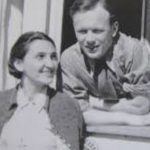 convinced his Nazi supervisors a typhus epidemic had broken out. The Nazis immediately quarantined areas with suspected typhus cases, including those with Jewish inhabitants. In 12 other villages, Eugene created safe havens for Jews through these quarantines. His work would eventually save 8,000 Jewish lives.
convinced his Nazi supervisors a typhus epidemic had broken out. The Nazis immediately quarantined areas with suspected typhus cases, including those with Jewish inhabitants. In 12 other villages, Eugene created safe havens for Jews through these quarantines. His work would eventually save 8,000 Jewish lives.
When the war ended, Eugene continued to practice medicine in Poland until he was forced to flee with his family to the United States. They settled in Chicago, where Eugene earned a medical degree from the University of Illinois. Decades later, he finally returned to Poland, where he received a hero’s welcome for saving those in desperate need of salvation through his unyielding love for humanity.
 Sometimes, people can associate certain things with certain religions, and even Satanism. They can then make decisions on life based on what they perceive something to be. Unfortunately, sometimes those decisions end up being disastrous. Such was the case with Pope George IX, who decided that cats where a part of devil worship, and so ruled that cats should be exterminated. Cats throughout Europe were exterminated in droves immediately thereafter. Of course, we know that while some religions might use certain animals in their religious practices, that does not make the animal evil…but rather, the animal is a victim of that religion, much like people in certain religions use snakes as a part of worship.
Sometimes, people can associate certain things with certain religions, and even Satanism. They can then make decisions on life based on what they perceive something to be. Unfortunately, sometimes those decisions end up being disastrous. Such was the case with Pope George IX, who decided that cats where a part of devil worship, and so ruled that cats should be exterminated. Cats throughout Europe were exterminated in droves immediately thereafter. Of course, we know that while some religions might use certain animals in their religious practices, that does not make the animal evil…but rather, the animal is a victim of that religion, much like people in certain religions use snakes as a part of worship.
After the cats were removed from Europe, an unexpected and horrific side effect occurred. The sudden lack of cats led to the spread of disease because infected rats ran free. The most devastating of these diseases, the Bubonic Plague, killed 100 million people. Pope Gregory lived from 1145 to 1241, AD, so little was known about how disease was passed. He was born Ugolino di Conti but took the name Gregory when he became the pope. That was when Ugolino was over 80 years old, not a young age to take on the papal role.
The cat fiasco is just one part of Pope Gregory IX’s story. He is mostly known for issuing the Decretals and starting the Papal Inquisition. The Decretals reorganized the whole library of Catholic laws. The papal inquisition rained down justice on heretics, the people who spoke out against the church. It was Gregory’s past  as a lawyer that connected him to his acts of justice within the church. It was his distaste for cats that penned the Vox in Rama (the papal decree – this one about the cats). That was the first church document condemning black cats as instruments of satan. By Gregory’s decree, there was a target on the head of every black cat. The Black Death or Black Plague was the original zombie apocalypse. People living during this time lived in constant fear of death. Many believed this was the end of the human race, and that is understandable. It was one of the most deadly pandemics in history. By rough estimates, as many as 200 million people died. If you survived, you lost many loved ones, and in Europe, it was all because of a lack of cats.
as a lawyer that connected him to his acts of justice within the church. It was his distaste for cats that penned the Vox in Rama (the papal decree – this one about the cats). That was the first church document condemning black cats as instruments of satan. By Gregory’s decree, there was a target on the head of every black cat. The Black Death or Black Plague was the original zombie apocalypse. People living during this time lived in constant fear of death. Many believed this was the end of the human race, and that is understandable. It was one of the most deadly pandemics in history. By rough estimates, as many as 200 million people died. If you survived, you lost many loved ones, and in Europe, it was all because of a lack of cats.
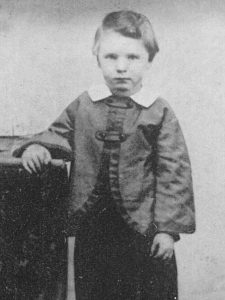 When we think of the White House, we seldom think of death. Oh, there have been presidents who were assassinated, or died while in office, but mostly not in the White House. It is too well guarded, and an ill president usually was taken to a hospital. Nevertheless, death has visited the White House, and the case I am referring to was not a president, but rather his son. Abraham Lincoln is my 7th cousin thrice removed, making his children, my 7th cousins 4 times removed. Lincoln married Mary Todd on November 4, 1842, in Springfield, Illinois. They were the parents of four sons Robert Todd Lincoln was born in 1843 and Edward Baker “Eddie” Lincoln in 1846. Edward died on February 1, 1850, in Springfield, probably of Tuberculosis. William Wallace “Willie” Lincoln was born on December 21, 1850, and died of a Typhoid Fever on February 20, 1862. The Lincolns’ fourth son, Thomas “Tad” Lincoln, was born on April 4, 1853, and died of heart failure at the age of 18 on July 16, 1871. While three of the four boys died in childhood, only one, Willie passed away in the White House.
When we think of the White House, we seldom think of death. Oh, there have been presidents who were assassinated, or died while in office, but mostly not in the White House. It is too well guarded, and an ill president usually was taken to a hospital. Nevertheless, death has visited the White House, and the case I am referring to was not a president, but rather his son. Abraham Lincoln is my 7th cousin thrice removed, making his children, my 7th cousins 4 times removed. Lincoln married Mary Todd on November 4, 1842, in Springfield, Illinois. They were the parents of four sons Robert Todd Lincoln was born in 1843 and Edward Baker “Eddie” Lincoln in 1846. Edward died on February 1, 1850, in Springfield, probably of Tuberculosis. William Wallace “Willie” Lincoln was born on December 21, 1850, and died of a Typhoid Fever on February 20, 1862. The Lincolns’ fourth son, Thomas “Tad” Lincoln, was born on April 4, 1853, and died of heart failure at the age of 18 on July 16, 1871. While three of the four boys died in childhood, only one, Willie passed away in the White House.
Disease was a scary thing in those days, because many serious diseases, which we have cures for now, were a death sentence in those days. Little Willie Lincoln had contracted Typhoid Fever. Typhoid fever, also known simply as typhoid, is a bacterial infection due to Salmonella Typhi that causes symptoms which may vary from mild to severe and usually begin six to thirty days after exposure. The disease was all over Washington DC, and  even the White House was not safe from it’s deathly grip. In fact, Willie was not the only one to have it. His brother, Tad was in bed just down the hall, with the same illness. Tad would survive, but I have to wonder if his heart was not severely weakened by the disease, because he passed away just nine years later of heart failure. On February 20, 1862, little 11 year old Willie succumbed to the Typhoid Fever at 5:00pm. His parents were with him, and Abraham Lincoln said, “My poor boy, he was too good for this earth. God has called him home. I know that he is much better off in heaven, but then we loved him so. It is hard, hard to have him die!” Mary watched him bury his head in his hands, “his tall frame convulsed with emotion.” At the foot of the bed she stood “in silent, awe-stricken wonder,” marveling that so rugged a man could be so moved. “I shall never forget those solemn moments — genius and greatness weeping over love’s idol lost.” President Lincoln then walked down the hall to his secretary’s office. He startled the half-dozing secretary with the news: “Well, Nicolay, my boy is gone — he is actually gone!” John Nicolay recalled seeing his boss burst into tears before entering his own office. I think I have to agree with Mary. When we think of Abraham Lincoln, we think of a strong man, but if we think about it, he also had a softer side, and he loved children.
even the White House was not safe from it’s deathly grip. In fact, Willie was not the only one to have it. His brother, Tad was in bed just down the hall, with the same illness. Tad would survive, but I have to wonder if his heart was not severely weakened by the disease, because he passed away just nine years later of heart failure. On February 20, 1862, little 11 year old Willie succumbed to the Typhoid Fever at 5:00pm. His parents were with him, and Abraham Lincoln said, “My poor boy, he was too good for this earth. God has called him home. I know that he is much better off in heaven, but then we loved him so. It is hard, hard to have him die!” Mary watched him bury his head in his hands, “his tall frame convulsed with emotion.” At the foot of the bed she stood “in silent, awe-stricken wonder,” marveling that so rugged a man could be so moved. “I shall never forget those solemn moments — genius and greatness weeping over love’s idol lost.” President Lincoln then walked down the hall to his secretary’s office. He startled the half-dozing secretary with the news: “Well, Nicolay, my boy is gone — he is actually gone!” John Nicolay recalled seeing his boss burst into tears before entering his own office. I think I have to agree with Mary. When we think of Abraham Lincoln, we think of a strong man, but if we think about it, he also had a softer side, and he loved children.
 Willie Lincoln was a favorite around the White House. In the words of a government official’s wife, “The White House is sad and still, for its joy and light have fled with little Willie. He was a very bright child, remarkably precocious for his age, and had endeared himself to every one who knew him.” Mary Lincoln’s cousin said he was “noble, beautiful…a counterpart of his father, save that he was handsome.” Mary herself called him the “idolized child, of the household.” It’s somewhat strange to think that such a large household as the White House, with all of it’s staff who work there, could be so changed by the death of a child, but Willie Lincoln was not an ordinary child. Had he been, he might not have come to the attention of everyone in the White House. Most of us know who the first children are but the White House staff knew Willie Lincoln and dearly loved him. As dates in history go, while this little boy was not an important man is the way we think of that today, he had a impact that went far beyond his short time on this earth, and his dying day was one that saddened a nation.
Willie Lincoln was a favorite around the White House. In the words of a government official’s wife, “The White House is sad and still, for its joy and light have fled with little Willie. He was a very bright child, remarkably precocious for his age, and had endeared himself to every one who knew him.” Mary Lincoln’s cousin said he was “noble, beautiful…a counterpart of his father, save that he was handsome.” Mary herself called him the “idolized child, of the household.” It’s somewhat strange to think that such a large household as the White House, with all of it’s staff who work there, could be so changed by the death of a child, but Willie Lincoln was not an ordinary child. Had he been, he might not have come to the attention of everyone in the White House. Most of us know who the first children are but the White House staff knew Willie Lincoln and dearly loved him. As dates in history go, while this little boy was not an important man is the way we think of that today, he had a impact that went far beyond his short time on this earth, and his dying day was one that saddened a nation.

 Alzhiemer’s patients, as you probably know lose their short term memory, but the more distant past is so clear that sometimes it seems like that is where they still live. In many ways, this is a truly sad fact of their lives, but if you look on the bright side of things, you can find a little bit of humor in an otherwise losing situation. And, when dealing with Alzheimer’s disease, you really need to find things to smile about. My mother-in-law and I have a very good relationship, but with Alzheimer’s disease, that doesn’t come without a few disagreements. As her mind progresses backward in time, she has become somewhat kidlike. Another problem she has is very itchy skin, and she scratches too hard, injuring her skin, so I have to stop her from scratching. Whenever I try to stop her, she says, “Don’t Esther!!” The first time she said that, it shocked me. My husband, Bob has an Aunt Esther, but we don’t look alike or anything, so I didn’t know where that came from.
Alzhiemer’s patients, as you probably know lose their short term memory, but the more distant past is so clear that sometimes it seems like that is where they still live. In many ways, this is a truly sad fact of their lives, but if you look on the bright side of things, you can find a little bit of humor in an otherwise losing situation. And, when dealing with Alzheimer’s disease, you really need to find things to smile about. My mother-in-law and I have a very good relationship, but with Alzheimer’s disease, that doesn’t come without a few disagreements. As her mind progresses backward in time, she has become somewhat kidlike. Another problem she has is very itchy skin, and she scratches too hard, injuring her skin, so I have to stop her from scratching. Whenever I try to stop her, she says, “Don’t Esther!!” The first time she said that, it shocked me. My husband, Bob has an Aunt Esther, but we don’t look alike or anything, so I didn’t know where that came from.
I had the pleasure of visiting with Esther a few days ago, and I mentioned this funny sequence os events, and told her that she was helping with Mom’s care clear from Oregon…or rather she was doing all the stuff that got me in trouble. I told her that it was better for me, if she was the one who got the blame. We had a nice little laugh and then she told me that she knew why she said that to me.
When Esther was a young girl, her family lived on a ranch in Montana. Her brother, Bob’s dad had married by then, and was living in town. Winters in Montana can be pretty severe, making it hard for kids to get to school from the outlying areas. Periodically, Esther came to stay with her brother and his wife, Bob’s mom. As you know, kids can be roudy, and mischievous. It doesn’t mean they are bad…just kids. Being a mom herself, my mother-in-law had to keep order in her house, so whenever Esther would do something she didn’t like, she would say, “Don’t Esther!!” Her own kids, she might spank, but it’s a little different with your sister-in-law, so her main recourse was simply to say, “Don’t Esther!!”
Now it all made sense. I always knew who she was talking about, but didn’t understand 
 how she was connecting me with Esther. We laughed about that for quite a while, and I told Esther that in my opinion it was better for her to take the blame, since she was a lot further away, and doesn’t have to have Mom really be mad at her. As for me, when faced with doing something my mother-in-law doesn’t like, or doesn’t want to do…well, I’ll just tell her that Esther did it. It will sure keep me out of trouble…sorry about that Esther!!
how she was connecting me with Esther. We laughed about that for quite a while, and I told Esther that in my opinion it was better for her to take the blame, since she was a lot further away, and doesn’t have to have Mom really be mad at her. As for me, when faced with doing something my mother-in-law doesn’t like, or doesn’t want to do…well, I’ll just tell her that Esther did it. It will sure keep me out of trouble…sorry about that Esther!!

